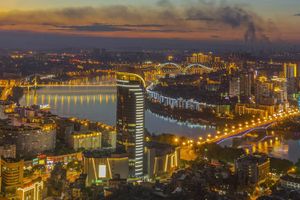Anhui Province Overview

GEOGRAPHY:
Anhui is a southeastern land-locked province of China. The watershed of the Huai River is in the north while the Yangtze River flows in the south. In the old days, even though the farmers worked hard, the flooding of the Yangtze caused a lot of damage to life and livelihood. Since the construction of the Grand Canal Irrigation System on the Yangtze River, the plains of Anhui have produced rich crops of wheat and rice. Tea has been cultivated in the hilly terrace plantations since centuries.
The Huangshan (Yellow Mountain) and Dabieshan mountain ranges dominate the landscape of the southern districts. The ranges are also a rich source of medicinal herbs, limestone, graphite, coal, fluorite, and iron; thus maintaining the prosperity of the region. The Yangtze flows through the terrain and provides the area with very picturesque landscapes and a multitude of tourist attractions.
There is a vast difference in the temperatures in the various districts. The northern plains have a moderate climate with rarely any extreme temperatures. While the southern regions experience extreme temperatures ranging between -1oC and 29oC, depending on the season and the topography. The months of June and July see very heavy rainfall and are not suitable for sightseeing.
CITYSCAPES:
China’s Anhui Province has a population of about 60 million, with the maximum density being in the urban areas. Hefei, the capital city is a bustling urban landscape with a well-defined infrastructure. Together with Wuhu and Anqing, Hefei has seen a lot of industrial development that includes healthcare, agro products, mining, automobiles, home appliances, iron and steel, alternate energy, robotics, constructions, information technology, etc.
The people in the northern plains are predominantly a farming community. Whereas, the people in the southern districts of Anhui Province are mostly working in the industries. Or they are involved in travel and tourism due to the presence of countless tourist attractions.
HISTORY & CULTURE:
Calligraphy is one of the most significant art forms in China and has been practiced since ancient times. Consequently, the manufacture of printing inks, ink stones, ink sticks, brushes, and rice paper has been a major industry in the Anhui Province. The Huangshan Ink Factory is a museum cum factory that still manufactures these products. Their Hui Ink and Xuan Paper are used even today by writers, artists, and calligraphers. There has always been a great emphasis on literacy and higher education so there are countless schools, colleges, and universities in the different parts of the Province.
Another significant characteristic of the region is its enormous archways. Arches were built in the ancient times to honor prominent citizens for their piety, loyalty, integrity, and charity. The Shexian County has the best-preserved and the largest number of ancient arches, some of which include ornately designed residences and gardens.
TRAVEL & TOURISM:
The Hefei Xinqiao International Airport and Huangshan International Airport serve innumerable airlines with connections to other cities in China and overseas. Most of the cities and larger towns are well connected via multi-lane expressways. Hefei and Wuhu have a comprehensive network of subways and underground railway systems that not only cater to the local industrial crowd but also to the hundreds of tourists that visit the Province all year round.
Majority of the tourist attractions of the Anhui Province are concentrated in the snow-capped mountain ranges and along the Yangtze and Huai Rivers. The most popular spot is the Lotus Peak Scenic Area (on Huangshan range) which is at an altitude of 1873 meters above sea level. Another popular site is the Huanggang Dabieshan Global Geopark. Both these scenic areas are UNESCO World Heritage Sites and have a plethora of tourist attractions. Some of them are ancient and some are modern, some are natural and others are manmade monuments. Cable cars are available for exploring these scenic areas.
Lake Chaohu located in the northern plains also contributes to some extent in making the region colorful and beautiful. The ancient Hongcun Village is a UNESCO World Heritage Site that looks like a Chinese painting. Its Hui houses, interconnected waterways, and bridges have been the subject of Hollywood films and countless paintings and murals.
The city of Hefei, although very urbanized in other ways, has the splendid Temple of Lord Baogong (memorial arch in honor of Lord Bao). Just 32Kms from the city is the Sanhe Ancient Water Town with its network of canals, ornate bridges, and buildings constructed during the Ming and Qing Dynasties.
The city of Wuhu is the perfect blend of the old and the new. It has old parks and temples, as well as modern street-food lanes and amusement parks. Anqing has the best ski-resorts, ski slopes, hot springs, and spas in the region. Whether you want a vacation for exploration, adventure, or relaxation; Anhui Province has something to offer every type of tourist.
Called Hui cuisine, the food specialties of the Province consist of healthy and wholesome dishes. Both rice and wheat are used extensively along with mixed vegetables, meat and seafood to conjure up the most delicious preparations. Some of the popular dishes are the Four Seasons tofu, Luzhou roast duck, Sanhe shrimp paste, Bagongshan stinky tofu, potato noodles, Wushan imperial goose, and seafood soup.
With so much to offer, it is no surprise that the Anhui Province of China is a prosperous region and a popular tourist destination.









